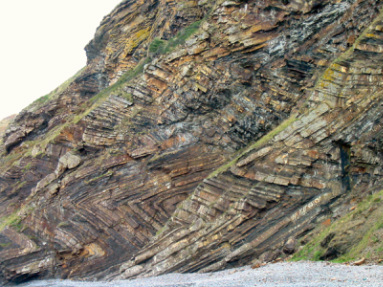 Enormous slabs of lithosphere move unevenly over the planet’s spherical surface, resulting in earthquakes. This chapter deals with two types of geological activity that occur because of plate tectonics: mountain building and earthquakes. First, we will consider what can happen to rocks when they are exposed to stress. Stress is the force applied to an object. In geosciences, stress is the force per unit area that is placed on a rock. Four types of stresses act on materials.
Enormous slabs of lithosphere move unevenly over the planet’s spherical surface, resulting in earthquakes. This chapter deals with two types of geological activity that occur because of plate tectonics: mountain building and earthquakes. First, we will consider what can happen to rocks when they are exposed to stress. Stress is the force applied to an object. In geosciences, stress is the force per unit area that is placed on a rock. Four types of stresses act on materials.
- A deeply buried rock is pushed down by the weight of all the material above it. Since the rock cannot move, it cannot deform called confining stress.
- Compression squeezes rocks together, causing rocks to fold or fracture. Compression is the most common stress at convergent plate boundaries.
- Rocks that are pulled apart are under tension. Rocks under tension lengthen or break apart. Tension is the major type of stress at divergent plate boundaries.
- When forces are parallel but moving in opposite directions, the stress is called shear. Shear stress is the most common stress at transform plate boundaries.
When stress causes a material to change shape, it has undergone strain or deformation. Deformed rocks are common in geologically active areas. A rock’s response to stress depends on the rock type, the surrounding temperature, and pressure conditions the rock is under, the length of time the rock is under stress, and the type of stress. The rocks then have three possible responses to increasing stress: elastic deformation, plastic deformation, or fracturing. Elastic deformation occurs when the rock returns to its original shape when the stress is removed. When rocks under stress do not return to its original shape when the stress is removed, it is called plastic deformation. Finally, when a rock under stress breaks, it’s called a fracture.
Under what conditions do you think a rock is more likely to fracture? Is it more likely to break deep within Earth’s crust or at the surface? What if the stress applied is sharp rather than gradual? At the Earth’s surface, rocks usually break quite quickly, but deeper in the crust, where temperatures and pressures are higher, rocks are more likely to deform plastically. Sudden stress, such as a hit with a hammer, is more likely to make a rock break. Stress applied over time often leads to plastic deformation.
Candela Citations
- Dynamic Earth: Introduction to Physical Geography. Authored by: R. Adam Dastrup. Located at: http://www.opengeography.org/physical-geography.html. Project: Open Geography Education. License: CC BY-SA: Attribution-ShareAlike
- Millook cliffs enh. Authored by: Smalljim. Located at: https://commons.wikimedia.org/wiki/File:Millook_cliffs_enh.jpg. License: CC BY: Attribution